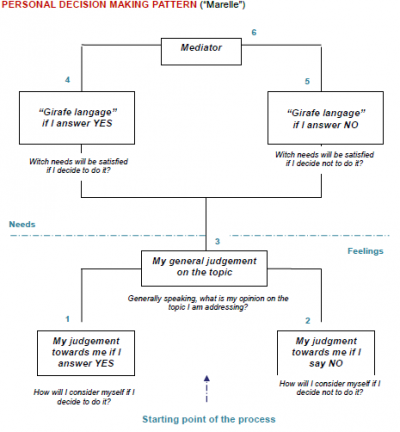User Tools
Sidebar
Table of Contents

Self empathy for decision making
Objectives
- Analyzing a situation
- Connecting to yourself (Self empathy)
- Weighing the pros and cons
- Making a personal decision on a complex issue
Scenario
Duration : 50 minutes (2 x 25 minutes)
Invite the participants to work on groups of 2 to reflect on a personal decision they have trouble taking. One after the other, they will help each other to analyze the situation and to imagine which needs will be satisfied or not depending on the decision they take.
For each round, one will talk and discuss the different options; the other will guide him/her through the process and takes notes to keep track of what is said.
The workshop starts with a question that summarizes the decision to take (For example: “Should I stop my studies and find a job or not?” or “Should I say to this girl that I have a crush on her or not?”).
From it, the person who expresses it (the “decision maker”) will imagine with the help of her pair (the “Facilitator”) what will happen if he/she decides to answer “YES”, and reversely, what will happen if he/she answers “NO”.
The “Facilitator” will guide the “decision maker” trough different stages : cf. schema below:
First, they will explore the FEELINGS: - How will the “decision maker” consider him/herself if he/she decides to do it? (= he/she answers YES to the question), - How will he/she consider him/herself if he/she decides not to do it? - Generally speaking, what does he/she think matter regarding this topic in life? (= general judgement / belief on the topic).
They will then analyze the NEEDS that will be satisfied:
- if the “decision maker” is answering YES - if the “decision maker is answering NO.
To finish, the “decision maker” will take some distance to analyze the PROs and CONs of both options, adopting an attitude of Mediation, towards him/herself and his/her situation.
In each stage the “facilitator” will ask questions to the other to help him/her list which will be the judgment(s) and possible consequence(s) of both possibilities, supporting him/her in his/her attempt to keep his/her ideas straight. When they arrive to the Mediator step, the “facilitator” will embody the “giraffe” (=the needs), which means he/she will encourage the “decision maker” to rephrase the benefits of both possibilities (the needs each of them answer to) and make a step towards taking the decision.
In case a decision is made, the “facilitator” will encourage the decision maker to include plan all the needs he/she expresses during the process in his/her action so that he/she can feel comfortable with what he/she has to do. Once the first person finishes, they change roles and start the process again: The “decision maker” becomes “facilitator” and the “facilitator” becomes “decision maker”, so that both of them will experience both roles and get the chance to address a personal issue and take a decision on it.

Material required
- Paper
- Photocopies of the process (schema) (x number of participants)



